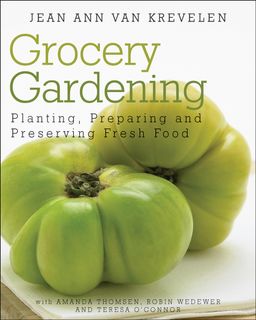The days are growing shorter. The temperatures are dropping. And old man winter will be here before we know it. Meanwhile, I can't help but wonder how gardeners in much colder climates survive the dark, dreary days of winter.
I'll be honest with you. In my USDA Hardiness Zone 6B garden, winters are relatively mild, especially compared to the rest of Idaho and the northern states. But what about those brave souls in the
really cold places? What about those regions where snowstorms come as early as October and frosts can continue until June? Ever wonder how they do it?
Well, keep reading. Five popular gardening writers, bloggers and tweeters share their winter survival tips:
Jodi Torpey
Jodi Torpey is a Denver-based garden writer, master gardener and author of "The Colorado Gardener's Companion: An Insider's Guide to Gardening in the Centennial State." In her Zone 5 garden, she saw snow
before Halloween this year.
"I'm convinced T.S. Eliot got it wrong," says Jodi. "April isn't the cruelest month, it surely must be January. I know those cold, dark days are coming when I do my planting in May. Then, in late August, I fill the freezer with containers of slow-roasted tomatoes, prepared chile peppers and home-made pesto. Every time I savor the garden-fresh aroma of a winter dinner bubbling on the stove, summer is within reach."
Learn more: www.WesternGardeners.com or follow her on Twitter @WesternGardener.
Amanda Thomsen
Amanda Thomsen (aka Kiss My Aster) knows something about cold winters too. From her Zone 5 garden in the Chicago area, she manages her busy life as a "blogger for
Horticulture magazine, garden Jedi, half of Good Enough Gardening podcasts, co-author of 'Grocery Gardening,' wearer of vintage clothing, Hello Kitty fan and thriftaholic."
How does she stay sane in the Windy City when those winds turn frigid?
"You know how I keep busy when the snow is knee deep?" she asked. "I search relentlessly for junk! It hardly matters what kind of junk; it sparks my creativity whether it's a dryer vent that can be repurposed or toys from the past that would look creepy in my garden come spring. I hit thrift stores, antique malls (the crapper the better), indoor flea markets and scour Craigslist.org. My winter revolves around junk. That and coffee."
Learn more: www.hortmag.com/kissmyaster/ or follow her on Twitter @KissMyAster.
Kathy Purdy
Kathy Purdy saw snow in upstate New York by October this year too. This popular blogger and cold climate gardening expert says her area was definitely Zone 4 about 20 years ago, but it's been leaning towards Zone 5 in recent years.
Translation: That means temperatures haven't dropped down to
minus 30 degrees Fahrenheit in a while. But she can still see frost the first week in June. So, how does she survive those long winters in the foothills of the Appalachian Mountains?
"The most important thing I do in the winter is train for strength and flexibility," explains Kathy. "It may not seem garden-related, but gardening in spring is much more pleasurable when your body is ready for physical labor, and it does keep your spirits up during the gloom. I also try to get out on milder days and stamp proposed paths or garden beds into the snow. Then I go upstairs to see how they look from above. I'm hoping this year to force more bulbs to have something fragrant and fresh in the house."
Learn more: http://www.coldclimategardening.com/ or follow her on Twitter @KathyPurdy.
Helen and Sarah Battersby
Helen and Sarah Battersby admit Toronto, Canada can get depressing in the dead of winter, especially for gardeners. And they would know. Descending from a long line of English gardeners, the sisters and neighbors write a popular gardening blog about Toronto together.
Here's how Sarah says she tackles Toronto's Zone 5 (
Canada Zone 6) winters:
"Winter in Toronto can be especially grueling," explains Sarah. "Any snow we get, if it stays around at all, quickly gets filthy. We don't have many perfect winter wonderland days here. This can send me screaming to
Allan Gardens, a Victorian conservatory in downtown Toronto. As soon as you walk in the door you're hit with warm, moist tropical air. There are three greenhouses: one cool, one warm, and a cacti and succulent room. Victorian sculptures, ponds with waterfalls and goldfish, and even a miniature mill with a water wheel, make the place magical for all ages."
Learn more: http://torontogardens.blogspot.com/ or follow on Twitter @torontogardens.
Lynn Felici-Gallant
Lynn Felici-Gallant spends winters on New Hampshire's scenic coast; also Zone 5. The garden writer, marketer and garden/container designer survives the cold weather by taking a philosophical look at the changing seasons.
"Each autumn, I lament the inevitable winter to come," admits Lynn. "I find myself holding on to the vestiges of my gardens with a vengeance, as if I might somehow stop the cold. And then, without warning, I begin to embrace the change of seasons; I savor the fragrant wood smoke from my stove, and relish Sundays with a pot of soup. I head outdoors as often as I can -- to walk in the woods, to track evidence of an evening critter, or to count the winter birds at my feeders. Slowly I realize the bare beauty of nature, stripped of the often overwhelming cacophony of summer flowers and foliage, and I feel grateful for the quiet."
Learn more: http://www.indigogardensllc.com/ or follow her on Twitter @IndigoGardens.
Tell us: How do
you survive winter? Have any winter survival tips you'd like to share?
.jpg)



































